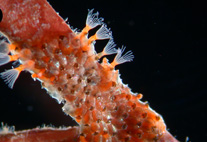Abstract
Watersipora subtorquata (d’Orbigny, 1852) has been widely reported as a fouling species from tropical to temperate waters. The continued confusion over the correct name for this species led us to provide a redescription of d’Orbigny’s type of Cellepora subtorquata, and to make comparisons with other species of Watersipora. We show that the majority of specimens assigned to W. subovoidea (d’Orbigny, 1852) are morphologically distinct from the recently erected neotype of W. subovoidea; these specimens are here reidentified as Watersipora subtorquata. Other specimens previously assigned to W. subtorquata belong to W. subatra (Ortmann, 1890), described originally from Japan. Owing these inconsistences, we suggest setting aside the neotype of Watersipora subovoidea, which is based on Busk’s Lepralia cucullata and is not from the same locality as d’Orbigny’s type. Watersipora cucullata is redescribed and figured using Busk’s specimens; the species is known from the Mediterranean, including the Adriatic. Three other species—Watersipora atrofusca (Busk, 1856), Watersipora aterrima (Ortmann, 1890) and Watersipora nigra (Canu & Bassler, 1930)—are also refigured. Watersipora edmondsoni Soule & Soule, 1975 is synonymised with W. subtorquata (d’Orbigny). Two new species are described, Watersipora mawatarii n. sp. from Japan and Watersipora souleorum n. sp. from the Azores, Cape Verde, Naples and Indian Ocean. A key is given to the Recent species of Watersipora.

